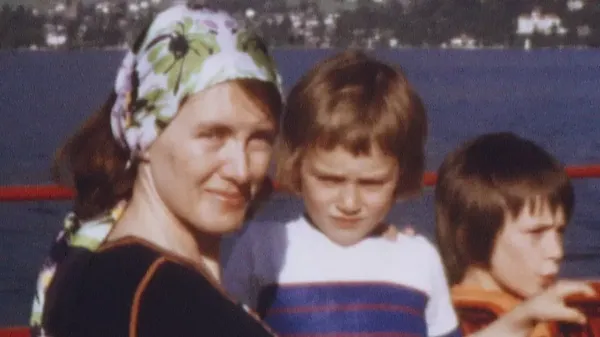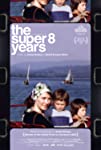Eye For Film >> Movies >> The Super 8 Years (2022) Film Review
The Super 8 Years
Reviewed by: Jennie Kermode

Even when we look back at periods of history which are well documented, with ample professionally archived records, we find that the personal diaries of those who lived through them enjoy enduring popularity. It’s always easier to relate to an individual’s experience, and even if it usually leaves many questions unanswered, it can put historical events into context in a way that makes them much more accessible. Traditionally, of course, such journals have been written. Annie Ernaux’s documentary, which screened to considerable acclaim at Cannes 2022, marks a point of transition, a historic shift in the medium itself. Recorded on film, these nostalgic family images open out into observations of a rapidly changing world.
“The camera was the ultimate desired object,” reflects Annie, who narrates the film herself. She and her husband, Philippe Ernaux, acquired it in 1972 and kept using it together until their separation in 1981, when he took it away and she kept the archive. He was the cinematographer but as he has since died, she has been free to take control of the story their footage tells, with the judicious assistance of editor Clément Pinteaux and her youngest son, David Ernaux-Briot. Fans of her books will note the similar thematic elements here, as a domestic tale gives way to recognition of a much bigger world.
The marriage is happy when the film begins; we can see it in the way that Philippe’s gaze lingers on his wife, the way he captures the shy smiles which will gradually give way to distance, thoughtfulness, and an increasingly apparent sense of self. Here, the children are young, Eric seven, David just three. They are living in a home which they have decked out, despite their limited means, in the style fashionable at the time, with popular items, carpets and wallpapers which older viewers across Europe will recognise at once. Living with them is Annie’s grandmother, who worries that she clashes with the décor, wearing the floral blue frocks of 30 years earlier. The footage is focused primarily on children beaming at the camera or playing lively games, but that will soon change.
Part of what makes this documentary so interesting is that the family did a lot of travelling, and although they were often restricted to tourist areas, Annie’s sharp awareness of this means that there’s still a fair bit of insight into what lay beyond. First up is a visit to Chile where Annie and Philippe met (but sadly didn’t film) Salvador Allende, then the big hope of the global left. The aftermath of his assassination, and Pinochet’s coup, resulted in a despondency which is keenly felt here, and saw the family retreat to the countryside where they could imagine themselves separated from politics for a while. Here we see the children running through woods and fields, wandering idly through a landscape of cobbled streets and tumbled grey stone cottages. It was a time, Annie recalls, when pollution and climate change were concepts only just beginning to seep into public awareness – a time when they imagined that these landscapes would never change.
Later, there’s a holiday in Morocco – or rather, a sort of imitation Morocco where everything is slightly bigger and cleaner and those locals permitted access have been carefully vetted, even down to the snake charmer. Then there is Beirut, in between terrorist attacks. Annie is 33 and has just sent away here first novel but has not yet had it accepted; her understanding of herself is beginning to change. Philippe’s footage of her looks as if it was filmed from a nostalgic perspective. Later they visit Albania, where the women are required to wear dresses, the men required to get bowl haircuts, and all visitors are forbidden to mix with locals. They explore ancient ruins, see fragments of arenas, grotesque faces topping pillars, mosaics, one featuring a a brightly coloured duck.
Time marches on. They join the new craze for skiing which brought unprecedented tourism to some parts of France. There’s London in the baking summer heat of 1976, with double decker buses and marching guards; Annie refers to it as the most exotic nearby country, and one can see what she means, with its peculiar pomp. Portugal is quieter, a place full of bucolic pastures and still inhabited Medieval towns. Moscow, in 1981, is mysterious – how much of it is real, how much for show? Communist display is everywhere yet it is the tsarist palaces which catch the eye. There is still a lengthy queue for Lenin’s tomb (when I visited seven years later, it was still open but attracted far less interest). By this time we hardly see Annie in the footage at all. Philippe’s lack on interest is plain in her absence. On the occasions that we catch sight of her face, her gaze is drifting far away.
The romantic, the familial and the geopolitical are inseparable here. The continuity of the archive gives it a quality distinct from that of piecemeal journalistic footage. Its personal quality makes it feel somehow more honest – the agendas involved in its capture are small ones, the events we glimpse often large. This is what it was like to be in this time, in these places, privileged enough to gain access, ordinary enough to be disregarded. This is how Annie Ernaux the writer was born, and how Annie the wife died. This was the world as we knew and loved it before we found ourselves, en masse, observing its disintegration.
Reviewed on: 16 Dec 2022

















